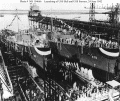Click On Image
For Full Size Image |
Size |
Image Description |
Contributed
By |
 |
61k | Henry Haywood Bell was born in North Carolina in 1808 and was appointed a midshipman on 4 August 1823. Highlights of his service before the Civil War were his time in Grampus as that schooner fought Caribbean pirates in the late 1820s and his command of San Jacinto during the mid 1850s. Under him, that screw frigate took the American diplomat, Townsend Harris, to Siam to establish diplomatic and economic relations between that kingdom and the United States. The ship then carried Harris to Japan where--following up Commodore Matthew C. Perry's diplomatic breakthrough--he became the first United States minister. The screw frigate subsequently participated in operations against the Chinese "Barrier Forts" between Whampoa and Canton before returning home in the summer of 1858. Following a period awaiting orders, Bell became the Navy's Assistant Inspector of Ordnance; and he held that post at the outbreak of the Civil War. Although a Southerner, Comdr. Bell remained loyal to the Union and initially labored to arm and to outfit the merchantmen that the Navy had purchased to blockade the Confederate coast. When the West Gulf Blockading Squadron was established early in 1862, Bell became Farragut's fleet captain and, as such, assisted the flag officer in administering the squadron and in capturing New Orleans. To prepare for operations against the "Crescent City," he reconnoitered the forts and river obstructions that protected it from attack by sea; and, shortly thereafter, he led the expedition that cut the chain across the Mississippi connecting floating barriers in the river. During Farragut's famous dash past Forts Jackson and St. Philip, Bell commanded the Union force's third division. On 1 July, Bell relieved Capt. Thomas T. Craven in command of Brooklyn. About a fortnight later, the Navy recognized Bell's outstanding service by promoting him to commodore, allowing him to skip the rank of captain. Commodore Bell was the squadron's highest ranking officer under Farragut; and he exercised immediate command of groups of Union warships in operations on the Mississippi, off Mobile Bay, and along the coast of Texas. Early in August 1863, Bell took temporary command of the squadron while Farragut returned north for a much needed rest; and, under his leadership, the squadron continued to operate effectively. After a somewhat rejuvenated Farragut returned to New Orleans on 23 January 1864, Bell--by then ill and exhausted--hauled down his broad pennant from the steam sloop Pensacola and returned home to recover his health. Following several months of rest up the Hudson at Newburgh, N.Y., where the high bluffs of the Catskill Mountains overlook the river, the commodore became the Commandant of the New York Navy Yard and held that post through the end of the Civil War. On 11 August 1865, Bell departed New York harbor in Hartford to reestablish the East India Squadron. Proceeding via the Cape of Good Hope, he reached Macao Roads on 4 February 1866 and spent the next two years laboring to restore respect for the United States in the Orient. He attained the permanent rank of rear admiral on 25 July 1866. His service in the Far East is most remembered for his struggles to suppress piracy along the China coast and to protect the lives and property of American citizens. On the morning of 11 January 1868, he drowned when his barge capsized in the surf off Osaka, Japan, while carrying him ashore for a farewell call on the United States minister there. Photo #: NH 56140. Rear Admiral Henry H. Bell, USN (1808-1868) portrait photo, taken circa 1866 by E. and H.T. Anthony, 591 Broadway, New York City. The original print is mounted on a carte de visite.
U.S. Naval Historical Center Photograph. | Bill Gonyo |
 |
61k | Undated, location unknown. | Don Scott, YNCS (SS) USN (Ret.) |





USS Stevens (DD-479) and USS Bell (DD-587) under construction in Charleston, May 15 1942. | Mike Mohl |
 |
207k | Post card of the launching of the USS Bell (DD-587) and USS Stevens (DD-479) at Charleston on June 24 1942. | Tommy Trampp |
 |
167k | USS Bell sliding down the building ways after being christened at the Charleston Navy Yard, South Carolina, on 24 June 1942. USS Stevens (DD-479) is alongside, awaiting launching (USN Photo No NH 104666). | Robert Hurst |
 |
116k | USS Bell (DD-587) and USS Stevens (DD-479) ready for launching at the Charleston Navy Yard, South Carolina, 24 June 1942 (USN Photo No 19-N-58158). | Robert Hurst |

| 335k | Postcard of the launching of the USS Stevens (DD-479) and USS Bell (DD-587) on June 24 1942. | Tommy Trampp |
 |
68k | Steaming down the Cooper River, Charleston in March of 1943. From the Charleston Shipyard archives. U.S. NAVY photo. | Robert Hall |
 |
151k | The commissioning crew, Charleston on March 4 1943. | Mike Mohl |


Charleston Navy Yard, March 31 1943. | Mike Mohl |






Charleston Navy Yard June 11 1943. | Robert Hurst/David Buell |

| 148k | Navy Photo 270-46, amidships looking aft plan view of USS McGowan (DD 678) with USS Bell (DD 587) below at Mare Island on 23 Jan 1946. McGowan was in overhaul at the yard from 6 Nov 1945 to 25 Jan 1946. | Darryl Baker |

| 116k | Navy Photo 272-46, forward plan view of USS McGowan (DD 678) with USS Bell (DD 587) below at Mare Island on 23 Jan 1946. | Darryl Baker |
 |
129k | A model of the USS Bell (DD 587) made by the Mare Island pattern makers is on display at Mare Island during Navy Day celebration on 27 Oct 1948. | Darryl Baker |


